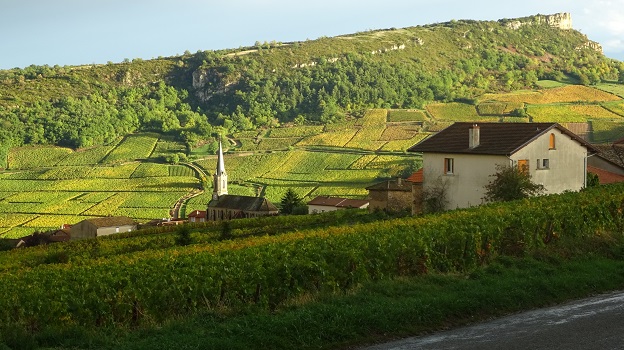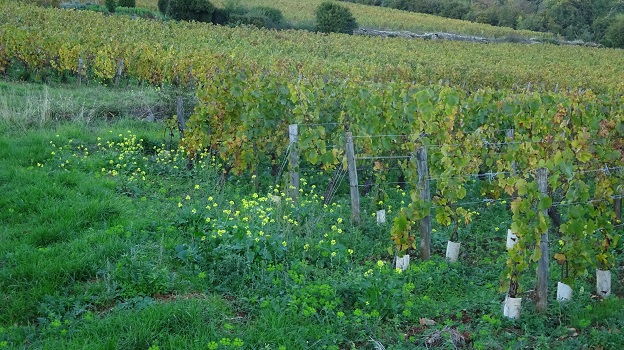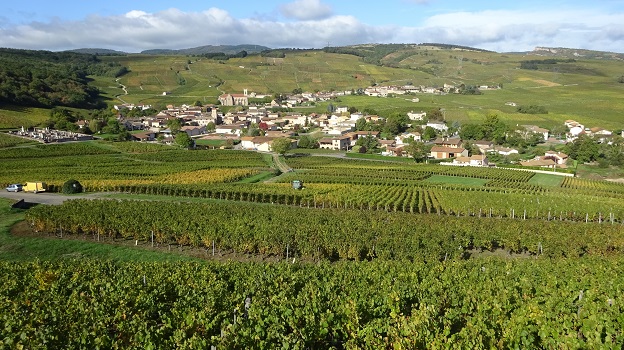Browse using the new Vinous website now. Launch →
Printed by, and for the sole use of . All rights reserved © 2015 Vinous Media
The Mâconnais on the Move
The Mâconnais region of southern Burgundy, an area with a long history of vine cultivation, has been radically transformed in recent decades. And the best is yet to come. There are still outstanding sites to be discovered and exploited in this large region bordered on the north by the Côte Chalonnaise and on the south by Beaujolais. Global warming has created the opportunity to ripen fruit in previously marginal areas. Even more important, a new generation of growers favoring quality over quantity has gotten far more serious about controlling yields and making wines with greater complexity, depth and potential longevity.
Vineyards in Solutré
From Backwater to Front Burner
As recently as the mid-1980s, the Mâconnais merited only a brief mention in books on the world’s fine wines. Pouilly-Fuissé was far and away the most important product of the region, although the business was controlled by a handful of négociants, most of them based outside the Mâconnais and simply interested in making large quantities of decent, bargain-priced wine. At the time, the American market absorbed an astounding 70% of this wine, as for casual consumers “fussy pussy” became synonymous with affordable, easy-drinking Chardonnay. (More than 90% of the region’s production is Chardonnay, the rest Gamay and Pinot Noir.)
Saint-Véran was typically the only other Mâconnais wine mentioned in wine books in the ‘80s, and this appellation had only been created in 1971 (its wines were previously bottled as Macon-Villages or Beaujolais blanc). The generic categories called Mâcon (blanc) and Mâcon (blanc) Supérieur, the latter then in the process of being changed to Mâcon-Villages, were of little interest to export markets. These wines were generally made at very high crop levels and did not have the concentration or structure to last more than a couple years in bottle. Few growers could get high enough prices for them even to consider making more serious wines.
The Mâconnais was also hurt by its failure to adopt a classification system of its top sites, as the Côte d’Or did in the 1930s. Without any official premier crus, the region’s labels were mostly opaque to consumers, who had little more than a few general place names and a smattering of well-known producer names to drive their buying decisions. To this day there are no official premier or grand crus in the region, only five village “crus”: Pouilly-Fuissé (which includes the villages of Chaintré, Fuissé, Solutré-Pouilly and Vergisson), Pouilly-Vinzelles, Pouilly-Loché, Saint Véran and Viré-Clessé. Happily, a premier cru system for Pouilly-Fuissé is in the works, and once this politically challenging project has been completed, consumers will be able to find and appreciate wines from favored sites that possess terroir character potentially every bit as distinctive as those of the Côte de Beaune. The Mâconnais, after all, shares geographic origins with the Côte d’Or, and benefits from similarly complex argilo-calcaire soils, with a range of rocks, marl, sandstone, granite and schist thrown into the mix. In fact, the series of limestone-rich outcroppings in Pouilly-Fuissé, many of them featuring very shallow topsoil over rock, also offer a wider range of expositions than are found in the Côte d’Or.
![]()
The iconic Roche de Vergisson
Today, the Mâconnais is a hive of activity, with talented and generally younger vignerons farming allegedly lesser sites more rigorously than ever before, often organically and with the objective of making denser, more concentrated wines by sharply cutting back on yields. They are planting new vineyards in microclimates that were once considered too cool or extreme to produce consistently ripe fruit. And there are probably lots of superb sites yet to be developed, many of them in the northwestern part of the region, in the third valley in from the Saône. Here the climate is hotter in summer and colder in winter and consistently less humid than spots closer to the river. And as climate change has reduced the incidence of damaging spring frosts since the 1990s, this area, with its wider diurnal variation, would appear to offer considerable potential—and perhaps for Pinot Noir as well.
Global warming has also made it possible for cooler and higher-altitude sites to produce seriously good wines and some of the region’s best values, not only in the already recognized appellation of Viré-Clessé, for example, but also in many of the 40+ villages that are only entitled to the Mâcon-Villages appellation (some of my favorites of these include Milly-Lamartine, La Roche Vineuse and Pierreclos, as well as those within the greater Pouilly-Fuissé area). And keep in mind that the AOC of Saint-Véran, which extends over eight communes separated by Pouilly-Fuissé in the middle, borders Pouilly-Fuissé in many spots. Often Saint-Véran enjoys the same stony argilo-calcaire soil and steep slopes as some of Pouilly-Fuissé’s top sites but is simply at higher altitude. The fruit here is far more likely to ripen fully nowadays, and the wines are capable of challenging Pouilly-Fuissé for quality at a much lower price.
In the bad old days before the emergence of artisan winemakers who lived in their vines, the wines of Pouilly-Fuissé, especially from the warmer villages of Pouilly and Fuissé, routinely displayed an exotic character in the riper years, with aromas and flavors of apricot, soft citrus and even tropical fruits, along with considerable fat and low acidity. But growers today are exploiting less sun-drenched expositions, picking earlier and with greater precision, and bottling much more vibrant wines. Meanwhile, the cooler villages of Solutré and especially Vergisson, in the extreme northwest of the Pouilly-Fuissé appellation, are enjoying surging popularity. There was a time when négociants avoided buying fruit from Vergisson for fear that it would be underripe. Today, Vergisson is the single most exciting source of Chardonnay from the Mâconnais, with its best wines combining density, delicacy, steely minerality and aromatic complexity in a way I associate with the best wines of the Côte de Beaune. In their precision and elegance, they’re a far cry from the old image of Pouilly-Fuissé as an opulent, sometimes heavy style of Chardonnay.
The wild, densely planted Perrières vineyard of Domaine Guillot-Broux in Cruzille, on ancient stone terraces
Recent Vintages in the Mâconnais
The 2014s, which are flowing into the market now and will continue to arrive over the next year or so, are classic wines from a benign growing season and a relatively early harvest. Thanks to a successful flowering, the crop was mostly full but rarely excessive at the level of the top growers, and the fruit ripened slowly and steadily during coolish, often cloudy weather in July and August without serious loss of malic acidity. Some estates started to pick as early as September 6 or 7 but they could take their time, as conditions remained favorable and the grapes were healthy. The vintage offered an unusual combination of an early harvest and lively acidity.
There’s little in the way of surmaturité in 2014 and the wines are rarely especially opulent, but they typically show a broad range of fresh aromas, lovely definition and tension in the mouth owing to harmonious acidity, good terroir-driven mineral character, and solid structure and grip. It’s a vintage that will give relatively early pleasure owing to its balance but should age well. Relatively few 2014s struck me as particularly austere in October, but there are some exceptions, especially among wines from Vergisson. I should note that my projected drinking windows for 2014s that I tasted in finished form may be conservative: the best wines kept under ideal cellar conditions may well evolve positively for longer.
Most of the producers I visited place 2014 in the same line as 2012 and 2010; as a rule the ‘14s show a bit less density but more fruit definition and acidity than the 2012s and lower acidity and less penetrating mineral character than the 2010s. But they may turn out to be the most harmonious—and perhaps the most complete—of these three vintages. Alcohol levels are generally moderate and rarely excessive. (The very early, hot vintage of 2015, on the other hand, brought record grape sugars across much of the region.)
Two thousand thirteen was a far more complicated year in the Mâconnais, as it was for Chardonnay on the Côte de Beaune. A rainy spring and a poor flowering set the stage for a small crop. The summer was much cooler than normal and the fall was rainy. The challenge for growers was to get their fruit ripe before rot ruined the grapes, and this was more likely to happen in the warmer southern part of the appellation. But even here, many growers couldn’t start picking until the beginning of October, as acidity levels in their grapes remained stubbornly high. The seeds of rot had been planted by then, and more than two inches of rainfall over the October 4-6 weekend followed by more precipitation on October 9 made the harvest an unpleasant adventure. Although they picked as quickly as they could, in many cases the fruit went directly from underripe to rotten.
But the vintage is by no means a washout. Those estates in the warmest spots were often in a position to bring in their best fruit during the last days of September, before rot became established and more rain fell. A minority of growers describe their 2013s as powerful and concentrated wines, due in large part to their very low yields, and a few even claim to prefer them to their 2014s. Well-drained hillside vineyards that benefit from good air flow often yielded precise, minerally wines that show little sign of compromised fruit. On the other hand, many wines show a distinctly exotic character from surmaturité or, more likely, from botrytis---sometimes noble rot but just as often its evil twin, grey rot. In the mostly cooler northern reaches of the Mâconnais, it was harder to get ripe fruit aromas before the rot took over. And yet the handful of best wines here show a penetrating character and noteworthy precision. Alcohol levels, even after chaptalization, are generally low in 2013.
From the hills above the town of Fuissé
In Praise of the Serious Stuff
Although there are also plenty of light and often delightful wines made mostly in tank, bottled early and intended for near-term consumption, at the level of the top growers I visited in October there’s a much higher percentage of altogether more serious wines that merit the interest of collectors, especially those who can no longer afford regularly to drink Chardonnay from the snob villages of the Côte de Beaune. Working with concentrated, ripe fruit, they are practicing non-interventionist winemaking; making greater use of oak, both barriques and larger barrels, relatively few of them new; and giving their wines longer élevage. In fact, a higher percentage of the producers I visited in October keep their top wines in barrel or in tank through a second winter than the estates I routinely visit on the Côte de Beaune. It’s too easy for producers in Meursault, Puligny and Chassagne to sell their wines these days; today, the best small growers of the Mâconnais are trying harder.
I have focused on the region’s top estates in this report—and, with very few exceptions, their Chardonnays—as opposed to co-op and négociant bottlings generally made in larger quantities and with less site specificity. (I have also omitted several wines from much smaller Côte d’Or-based négociants as these wines were not available to me this fall.) During a week in October I visited more than two dozen estates and tasted current releases from a number of additional growers that belong to the Artisans Vignerons de Bourgogne du Sud group. This steadily growing association of producers, created in 2004 by Olivier Merlin, Fabio Montrasi, the Bret brothers, Dominique Lafon and others, has expanded to include a high percentage of the Mâconnais’s most quality-conscious smaller producers, including a number of young rising stars who work for the most part organically and harvest by hand. I followed up my October visit to France by tasting a few more wines in New York in November.
You Might Also Enjoy
The 2014 & 2013 White Burgundies, Stephen Tanzer, August 2015
Chablis: 2014 & 2013, Stephen Tanzer, August 2015
The 2012 Red Burgundies from Bottle, Stephen Tanzer, March 2015
The 2013 Red Burgundies, Stephen Tanzer, January 2015
--Stephen Tanzer
Show all the wines (sorted by score)
- André Bonhomme
- Bret Brothers
- Céline & Laurent Tripoz
- Château de Beauregard/Joseph Burrier
- Château des Quarts
- Château des Rontets
- Château Fuissé
- Clos des vignes du Meynes/Julien Guillot
- Domaine Cheveau
- Domaine Cordier Père et Fils
- Domaine Corsin
- Domaine Daniel et Julien Barraud
- Domaine de Chervin
- Domaine de la Bongran/Jean Thévenet
- Domaine de la Chapelle/Cathérine and Pascal Rollet
- Domaine Denis Jeandeau
- Domaine de Roally
- Domaine des Chazelles - Jean-Marie Chaland
- Domaine des Vieilles Pierres/Jean-Jacques Litaud
- Domaine de Thalie/Peter Gierszewski
- Domaine Frantz Chagnoleau
- Domaine Gilles Morat
- Domaine Giroux
- Domaine Guerrin & Fils
- Domaine Guffens-Heynen
- Domaine Guillot-Broux
- Domaine Henri Perrusset
- Domaine J.A. Ferret
- Domaine La Vigne Mouton/Delphine & Sebastien Boisseau
- Domaine Leflaive
- Domaine Marc & Sophie Guillemot-Michel
- Domaine Maurice Martin
- Domaine Nicolas Maillet
- Domaine Pascal Bonhomme
- Domaine Pierre Vessigaud
- Domaine Robert-Dénogent
- Domaine Sainte Barbe/Jean-Marie Chaland
- Domaine Sangouard-Guyot
- Domaine Saumaize-Michelin
- Domaine Thévenet & Fils
- Domaine Valette
- Dominique Cornin
- Émilian Gillet
- Jacques Saumaize
- Joseph Drouhin
- Les Héritiers du Comte Lafon
- Maison Verget
- Olivier Merlin
- Rijckaert
- Roger Lassarat



